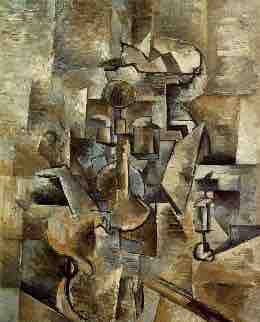Cubism
Cubism was an avant-garde art movement of the early 20th century pioneered by Georges Braque and Pablo Picasso, and later joined by Juan Gris, Jean Metzinger, Albert Gleizes, Robert Delaunay, Henri Le Fauconnier, and Fernand Léger. The movement revolutionized European painting and sculpture and inspired related movements in music, literature, and architecture. Cubism has been considered the most influential art movement of the 20th century .

Georges Braque, Violin and Candlestick, 1910
Georges Braque, with Picasso, was one of the founders of Cubism.
In Cubist artwork, objects are analyzed, broken up, and reassembled in an abstracted form. Instead of depicting objects from one viewpoint, the artist depicts the subject from a multitude of viewpoints to represent the subject in a greater context.
Constructivism
Constructivism was an artistic and architectural philosophy that originated in Russia in 1919. It entailed a rejection of the idea of autonomous art and was in favor of art as a practice for social purposes. Constructivism had a great impact on modern art movements of the 20th century, influencing major trends such as Bauhaus and the De Stijl movement. It is difficult to isolate a particular aesthetic common to the constructivist philosophy as it is so broad, but it can be roughly distinguished by its use of bright, bold color and geometric designs, especially in graphic design.
The First Working Group of Constructivists (including Liubov Popova, Alexander Vesnin, Rodchenko, Varvara Stepanova, and the theorists Aleksei Gan, Boris Arvatov and Osip Brik) developed a definition of Constructivism as the combination of faktura: the particular material properties of an object, and tektonika, its spatial presence. Initially the Constructivists worked on three-dimensional constructions as a means of participating in industry. Later the definition would be extended to designs for two-dimensional works such as books and posters.
Proun Vrashchenia by El Lissitzky c. 1919
The geometric forms and bright colors in this painting are characteristic of the Constructivist aesthetic.
Futurism
Futurism was an Italian movement that emphasized and glorified themes associated with contemporary concepts of the future such as speed, technology, youth and violence, as well as objects such as the car, the airplane, and the industrial city. In 1910 and 1911 futurist painters made use of the technique of divisionism, which entails breaking light and color down into a field of stippled dots and stripes. Severini was the first to come into contact with Cubism. Following a visit to Paris in 1911, the Futurist painters adopted the methods of the Cubists. Cubism offered them a means of analyzing energy in paintings and visually expressing their desired focus on dynamism, motion and speed. The adoption of Cubism determined the style of much subsequent Futurist painting.

Giacomo Balla, Abstract Speed + Sound, 1913–1914
This is a seminal work from the Futurist movement which was influenced by Cubism.